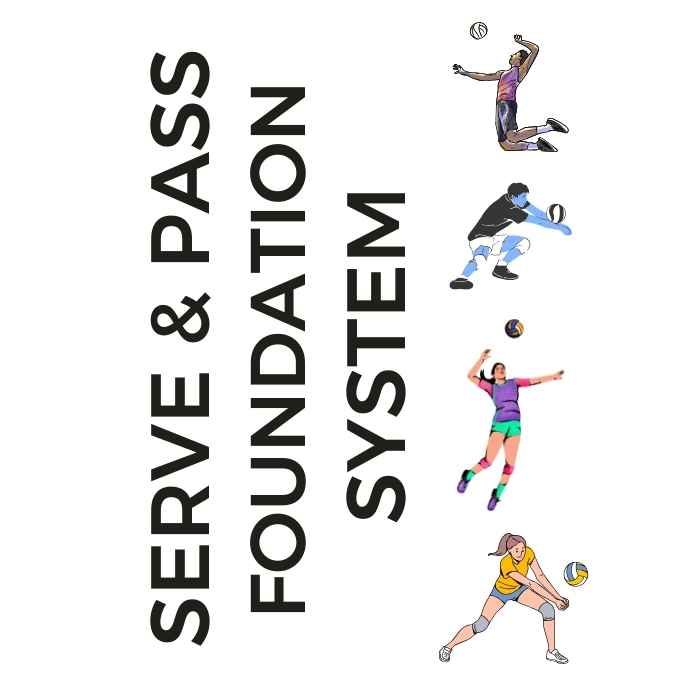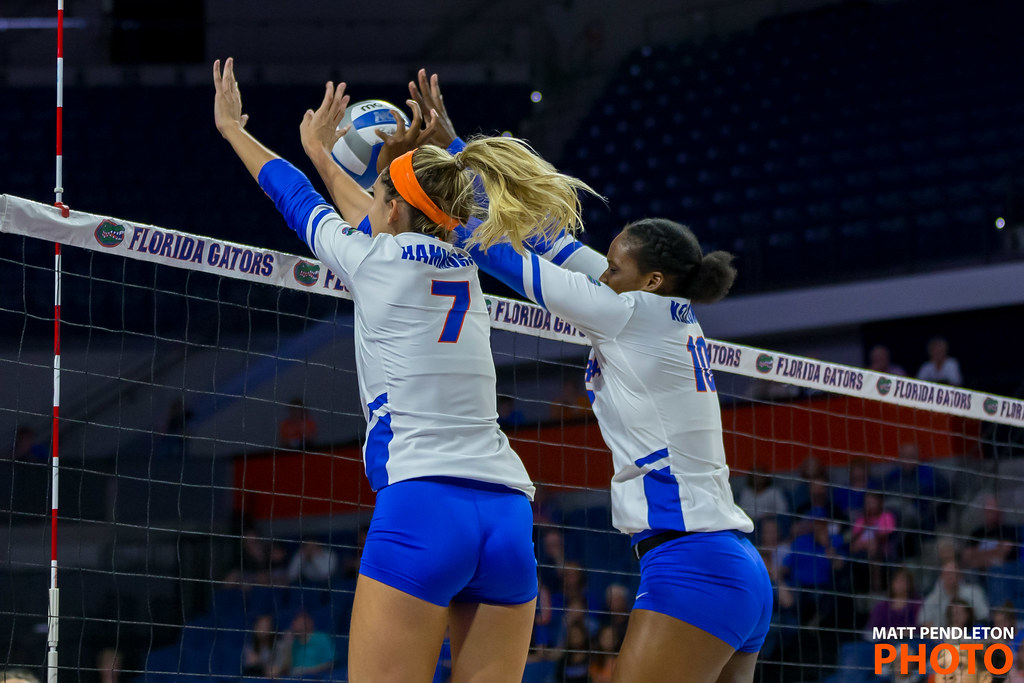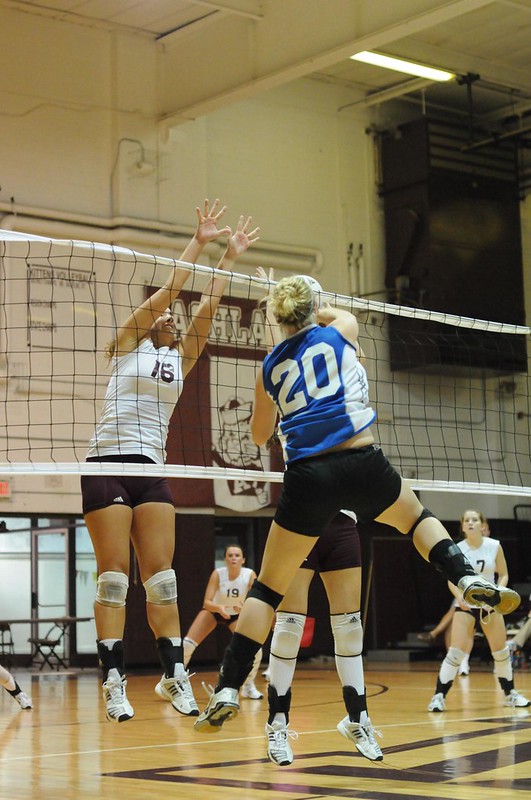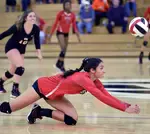
Serve + Pass Foundation System: The Complete Skills Arsenal The two-skill mastery system that transforms inconsistent players into the athletes coaches build their lineups around. Stop Struggling With The Two Most Important Skills In Volleyball!
- Improve Your Volleyball with Coach April
- Basic Volleyball Terms For Blocking A Ball At The Net For Points
- Blocking Techniques in Volleyball Used In Defense At The Net
Seven Blocking Techniques in Volleyball Used In Defense At The Net
Some important blocking techniques in volleyball are sealing the net, stuff block, read blocking, cross court block, swing block, commit block, delayed block
Welcome to my complete guide on volleyball blocking techniques!
In this article, I explore a range of strategies designed to elevate your blocking game.
From the fundamental "seal the net" technique to the advanced skills of the "swing block," "cross-court block," "commit block," and "delayed block," I will equip you with the knowledge and tools to become a formidable force at the net.
Blocking Volleyball Drills:
Skinny Court Two vs Two during Breakfast Club with Coach April
To start, I'll dig into the technique known as "seal the net" where players focus on creating a solid barrier by keeping their bodies parallel to the net, minimizing the space between them and the net itself.
Building upon this foundation, we'll introduce the "swing block," a dynamic technique that involves mimicking the trajectory of the hitter's arm swing with your own blocking motion.
Moving on, we'll tackle the "cross-court block," a strategic move that aims to counter hitters who prefer attacking diagonally across the court. By recognizing patterns in hitting and positioning yourself accordingly, you can utilize this technique to intercept their intended trajectory and disrupt their attack.
Next, I'll go over the "commit block," a technique that requires reading the situation and observing hitter tendencies and making decisive action in a short amount of time.
Finally, I talk about the "delayed block," a skill that involves timing your jump slightly later than usual, allowing the hitter to commit to their shot before launching your block.
Throughout this guide, I'll provide step-by-step instructions, tips, and examples for each technique to ensure a thorough understanding of their execution.
Blocking Techniques in Volleyball:
Seal The Net
1. Blocking Technique: Seal the Net
- Step 1: Position yourself correctly: Stand at the net with your feet shoulder-width apart, facing the hitter.
- Step 2: Keep your body parallel to the net: While jumping, focus on maintaining your shoulders, chest, underarms, upper body, chest, abs, and hips parallel to the net.
- Step 3: Close the gap: Try to minimize the space between your body and the net without actually touching it.
- Step 4: Maintain the block: Even as you come down from your block jump, continue to keep your arms and hands close to the net to prevent any chance of the ball slipping through.
- Tip:
Focus on timing your jump and pressing your hands over the net to create a solid block.
- Example: In the photo below, the players are successfully sealing the net by keeping a small gap between their body and the net.
When you "seal the net" it means that when you are in the middle of your block, while you are jumping, you need to keep your shoulders, chest, your underarms, upper body including your chest, abs and hips parallel to the net, all while keeping as little space as possible between you and the net...without touching it.
 Maintain the block: Even as you come down from your block jump, continue to keep your arms and hands close to the net to prevent any chance of the ball slipping through.
- Tip: Focus on timing your jump and pressing your hands over the net to create a solid block.
(photo Matt Pendleton)
Maintain the block: Even as you come down from your block jump, continue to keep your arms and hands close to the net to prevent any chance of the ball slipping through.
- Tip: Focus on timing your jump and pressing your hands over the net to create a solid block.
(photo Matt Pendleton)The photo above shows a great picture of volleyball players sealing the net with their block which you can see very well from this side view.
Can you see how little space there is between their blocking hands, arms and bodies and the net?
There's very little. Each player's armpits are as close to the net as possible without touching it.
They have successfully done their job and even on the way down from their block jump they keep their arms and hands as close to the net without touching it to prevent any chance of the ball slipping in between them and the net on their side.
Blocking Techniques in Volleyball:
Read Blocking
Blocking Techniques: Read Blocking
- Step 1: Assign a hitter to block: Prior to the play, communicate with your teammates and identify the specific hitter you are responsible for blocking.
- Step 2: Follow the hitter's movements: As the play develops, track the movements of your assigned hitter to anticipate where they will attack the ball.
- Step 3: Adapt your block: Adjust your positioning and footwork to block the hitter by penetrating over the net and extending your arms and shoulders so they're in the path of the extension of the hitter's spiking arm, no matter where they are on the court.
- Tip:
Focus on reading the hitter's body language, approach, and hitting tendencies to predict their shots.
- Example: In higher levels of competition and beach volleyball, read blocking is commonly used to anticipate the hitter's actions and effectively block their attacks.
Read blocking occurs when a blocker has been assigned a particular hitter to block and as the play develops they follow, or read where their assigned hitter is going to attack the ball and their job is to follow that player no matter where she is and to block her.
The read block in volleyball occurs most often in higher levels of competition and in beach volleyball where a blocker will read the hitter in an attempt to anticipate how to block them or to decide what area of the court they will take away from that hitter.
The other blocking volleyball system that leaves less decision-making to the player and more to the coach is where the coach determines what area of the court all the blockers will cover or take away, instead of the player.
It's usually the coach that will decide volleyball blocking strategies which include deciding whether his/her team will block cross court against the opposing team or if only some of the coach's players will be responsible for sticking to this game plan that was established off the court or before the game.
Especially in NCAA competition it takes time and plenty of drills and reps for college volleyball players to become good at reading the block in volleyball.
Blocking Techniques in Volleyball:
Stuff Block
Blocking Technique: Stuff Block
- Step 1: Time your jump: Anticipate the hitter's contact with the ball and time your jump to maximize your blocking height and penetration over the net.
- Step 2: Penetrate the net: Extend your arms and hands over the net as far as possible to block the attacker's hitting space.
- Step 3: Angle your hands downward: Direct your hands towards the middle of the opposing team's court to "stuff" the ball back into their side of the net.
- Tip:
Focus on maintaining a strong and solid block by pressing your palms and fingers firmly over the net.
- Example: When a blocker successfully stuff blocks the ball, they eliminate the hitter's options and prevent them from finding an open spot on the court.
The blocker was able to penetrate their hands so far over the net that they literally "stuffed" the ball back into the opposing team's court leaving the hitter no court to hit to.
Blocking Techniques in Volleyball:
Swing Block
1. Technique: Swing Block
- Step 1: Observe the hitter's approach: Pay close attention to the hitter's movements and positioning as they approach to hit the ball.
- Step 2: Time your jump and swing motion: Jump while extending your arms up and slightly to the side, as if mimicking the trajectory of the hitter's arm swing.
- Step 3: Angle your block towards the direction of the hit: Adjust the positioning of your hands and arms to redirect the ball's trajectory based on the anticipated swing of the hitter.
- Tip:
Maintain a strong core and explosive jump to generate power and reach high above the net.
- Example: When executing a swing block against a hitter aiming for a cross-court shot, your arms will be angled in that direction, ready to redirect the ball back.
Blocking Techniques in Volleyball:
Cross Court Block
Technique: Cross-Court Block
- Step 1: Recognize the hitter's hitting tendencies: Analyze the hitter's patterns and determine if they prefer to attack cross-court.
- Step 2: Position yourself accordingly: Move laterally to position yourself closer to the hitter's intended trajectory for a cross-court shot.
- Step 3: Angle your block towards the cross-court area: Extend your arms and hands in a manner that intercepts and redirects any cross-court shots.
- Quick Tip To Help You Improve:
Quickly read the hitter's arm swing and aim to intercept the ball before it reaches its intended target area.
- Example:
If a hitter has consistently been attacking cross-court, a well-timed cross-court block will stop their tendency to hit their favorite cross court shot which forces them to do something that they're not so good at making it easier for your defense to pick up
Blocking Techniques in Volleyball: Commit Block
- Step 1: Anticipate the hitter's intended shot:
Based on studying and remembering the hitter's tendencies commit to blocking a specific area of the court by lining up on that hitter to "take away" or block that particular part of the court which forces them to hit into you or to hit away from you ...towards you waiting defense behind you
- Step 2: Position yourself to cover the committed area:
Adjust your footwork and body positioning to cover the specific area and to limit the hitter's options.
- Step 3: To execute a strong block watch the hitter's spiking arm and go up and penetrate your arms over the net right as the spiker has started their armswing.
- Blocking Tip To Remember:
Maintain a focused mindset and avoid being pulled out of position by decoy moves or misdirection from the opposing team.
- Example:
In a situation where a dangerous hitter consistently attacks from a particular zone, a commit block allows you to effectively shut down their preferred hitting spot.
Blocking Techniques in Volleyball:
Delayed Block
Blocking Techniques: Delayed Block
- Step 1: Start in a ready blocking position:
- Step 2: Time your jump: Delay your jump slightly, allowing the hitter to commit to their attack hit so just as their arms swing forward and they commit to their hit before contacting the ball you jump to block.
- Step 3: Press your arms, shoulders and hands as far over the net as possible:
Time your jump so you jump just after the hitter does and you press both arms over the net right as the hitter swings .
- Tip:
Keep your focus on the hitter and be patient with your timing to maximize the effectiveness of the delayed block.
With these additional blocking techniques, you'll have a diverse set of skills to employ in different game situations.
Remember to practice each technique regularly to improve your timing, positioning, and effectiveness at the net.
Do You Follow Me on Pinterest?
Follow me on Pinterest Volleybragswag to improve your game even faster!
I share alot of individual, partner and easy-to-do volleyball serving drills we do in class with my followers.
Many of these volleyball practice drills you can do at home by yourself or try at your next practice with your teammates.
If you're a B team or JV player trying to make varsity next year...your goal should be to complete 1000 reps a day of at least three of the basic skills on your own...volleyball passing, serving and setting should be at the top of the list.
Blocking Techniques in Volleyball
Where do you need to go now?
Here are three options:
- Learn more about the volleyball words, terms and terminology in the Related Links below.
- Follow the suggested reading on our Sitemap page Learning How To Play (Sitemap)
- Or visit the pages in the Information section in the drop down menu at the top of the page.
If your athlete struggles with consistent serve receive, gets subbed out, or is overlooked for playing time—this is the fix you’ve been looking for.

Struggling with passing consistency?
I help talented passers tired of getting pulled from games because of inconsistent serve receive skills BUILD passing confidence without expensive private lessons using the same 3-step system that's helped dozens of my athletes get recruited.
Download my eBook for $17.99 and start building the passing confidence that keeps you on the court—and gets you seen by college coaches.
From Lady Vol to Legend: Coach April Produces Powerful Passionate Players...is that you?
What Are You Looking For?
Click to Download Your Pre Serving Ritual Mastery Checklist pdf:
🎯Volleyball Pre Serving Ritual Guide -
Players! Learn How To Transform Your Serve from Weak to Weapon
Click to Download Your Parent's Volleyball Serving Checklist pdf
🎯Parent's Volleyball Serving Checklist Guide
Parents! Help Your Player Develop Championship Serves (Even If You've Never Played)

Hi there!
Thanks for stopping by. Hope you learned something today that will help you reach your volleyball goals.
Be sure to subscribe to my email newsletter so you can learn more each week!
Stay strong! Stay motivated!
-Coach April

SUSCRIBE to my email newsletter below!
 Click to learn more about the weekly volleyball classes and clinics or email info@imrpoveyourvolley.com for information
Click to learn more about the weekly volleyball classes and clinics or email info@imrpoveyourvolley.com for informationCongratulations to my seven Boys-18s Vegas Volley club players who played in two state championship finals yesterday, the 3A and 5A State champinship finals at Sunrise Mountain High School.
TOURNAMENT CHAMPIONS!
A-1 Vegas Volley VBC
In It To Win It Tournament
May 2 - 4, 2025 Tournament
Gold Medalists
18s Premier Division
Vegas Volleyball's Unsung Heroes: Celebrating Moms with Peace Love Volleyball Shirts
Ready to energize your volleyball mom journey?
Subscribe to my 'Producing Powerful Passionate Peaceful Players' email list above on ImproveYourVolley.com.
You'll receive energy-boosting tips, exclusive insights from me, Coach April Chapple on maintaining momentum in volleyball.
Let's power up the Vegas volleyball scene together!
Recent Articles
-
5 Essential Serving Tips from Tennessee's #2 Career Aces Record Holder
Dec 09, 25 11:39 PM
I've identified the 5 essential serving tips that separate confident servers from struggling ones and you'll serve with the confidence that creates aces -
The Volleyball Toss How Consistent Is Your Ball Toss Before You Serve?
Dec 07, 25 12:29 AM
The volleyball toss for the overhand serve needs to consistently be two feet up in the air and one foot in front of front foot which puts the ball in front of your serving arm. -
Shop Small: Real Volleyball Training With + Results From A Real Coach
Dec 03, 25 10:30 AM
Support a woman-owned business. Get training from a former elite pro with 13+ years coaching experience. Ditch the big box store--invest in proven results.





















































